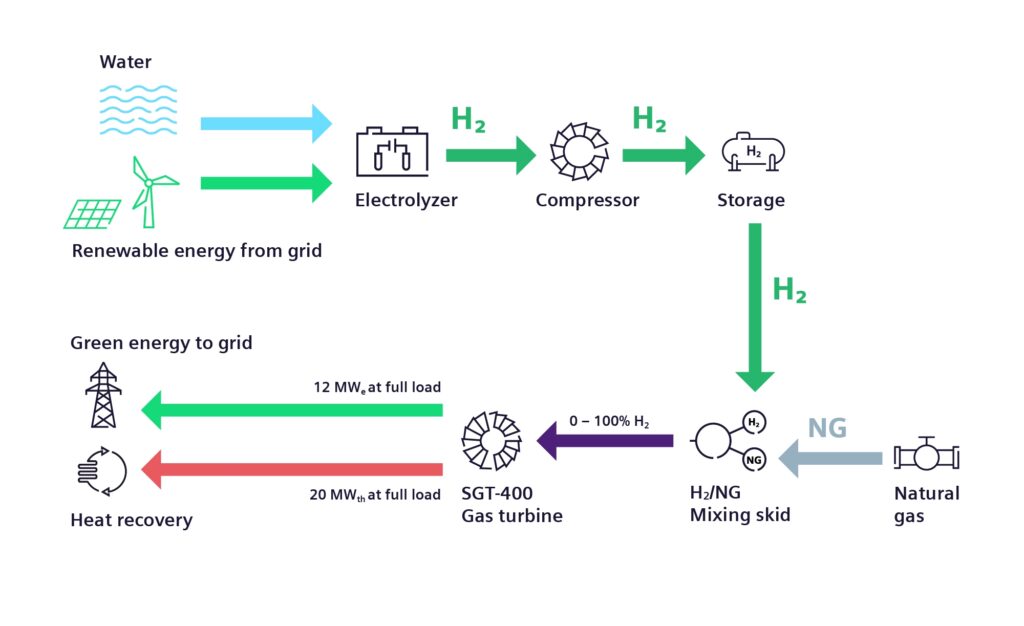Siemens-Led Group Completes Test of 100% Renewable Hydrogen in Gas Turbine
A consortium that includes power industry giants Siemens Energy and ENGIE said it completed what the group called the world’s first operational test of a gas turbine fueled with 100% renewable hydrogen.
Siemens Energy on Oct. 13 said the HYFLEXPOWER consortium conducted the test using a gas turbine at Smurfit Kappa, a paper packaging company in Saillat-sur-Vienne, France. The consortium also includes Centrax, a UK-based gas turbine manufacturer; Arttic, a French consultancy; the German Aerospace Center, known as DLR; and four Europe-based universities.
The project in France involves producing and storing renewable hydrogen at the Smurfit Kappa site. Smurfit Kappa is headquartered in Dublin, Ireland. The company produces corrugated packaging, containerboard, and other paper packaging products.
Pursuing a Hydrogen-Fueled Turbine Fleet
“The knowledge and experience gained from the HYFLEXPOWER project where we installed the first gas turbine to run on 100% hydrogen will help us to continue develop our entire gas turbine fleet for a hydrogen-based future,” said Karim Amin, member of the executive board of Siemens Energy. “The interaction between electrolysis, storage, and hydrogen conversion at one site has been impressively demonstrated, and now it’s a matter of scaling the results.”
The hydrogen at the French manufacturing facility is produced by a 1-MW electrolyzer at the site. It is then stored in what Siemens called “an almost one-ton tank and used to power a Siemens Energy SGT-400 industrial gas turbine.” Siemens said the project “demonstrates that hydrogen can be used as a flexible energy storage medium, and that it’s also possible to convert an existing gas-fired power turbine to operate using renewable hydrogen.”

“We’re proud that our Saillat paper mill has been the host for this project because trialing new and emerging technology, such as hydrogen, aligns with our decarbonization strategy and Better Planet 2050 journey. Today’s announcement is a great milestone that puts us in good stead,” said Garrett Quinn, chief sustainability officer at Smurfit Kappa.
Siemens Energy, which is leading the consortium, said the success of the HYFLEXPOWER demonstration in France already has led to a planned expansion of the group to include additional members. Siemens in a news release wrote, “Having tested HYFLEXPOWER for electricity production, the goal is now to extend its operation to industrial heat production and additional operational modes. It is also planned to explore ways of scaling up and commercializing decarbonized electricity generation.”
Want to learn more about Siemens Energy and its efforts to support a hydrogen economy? Read this special report, “At the Dawn of the Hydrogen Economy,” and also read this commentary from a company executive in the September 2023 issue of POWER.
The group has said using renewable hydrogen would support accelerated decarbonization efforts for energy-intensive industries. Siemens Energy supplied the electrolyzer for hydrogen production, and also developed the hydrogen gas turbine. Engie has been in charge of production, storage, and the supply of hydrogen for the project. Centrax has updated the system for safe hydrogen fuel operation.
‘Proud of this World First’
“At ENGIE, we are very proud of this world first,” said Frank Lacroix, the company’s executive vice president in charge of Energy Solutions. “The HYFLEXPOWER project is remarkable for many reasons: for the exceptional collaboration it has enabled between several European partners, for the forward-looking technologies it has tested, and for the promising prospects it opens up for the use of renewable hydrogen in the industrial sectors most difficult to decarbonize. We look forward to continuing this decisive work for the future of decarbonized industry with our partners.”
The German Aerospace Center (DLR), along with the universities of Lund, Duisburg-Essen, and University College London, have contributed to the project, helping develop the hydrogen turbine technology. Arttic supported the project’s operational management. The group said the National Polytechnic University of Athens conducted an economic, environmental, and social analysis of the project’s concept.
Project in Normandy
Siemens Energy also recently announced it would supply 12 electrolyzers with a total capacity of 200 MW to Air Liquide’s Normand’Hy project in Normandy, France. Air Liquide, a global gas and technology company, will operate the electrolyzers at the company’s plant in the Port-Jérôme industrial zone, beginning in 2026.
The companies said the plant will produce 28,000 tones of renewable hydrogen annually for use by industry and the transportation sector. Siemens Energy and Air Liquide in 2021 announced an agreement to work on hydrogen technology projects.
“The sustainable decarbonization of industry is unthinkable without green hydrogen. That is why projects like this are so important,” said Anne-Laure de Chammard, member of the executive board of Siemens Energy. “But they can only be a starting point for a sustainable transformation of the industrial landscape. Other large-scale projects must follow quickly. For the development of a European hydrogen economy to succeed, we need reliable support from policymakers and simplified procedures for funding and approving such projects.”
Siemens Energy said the electrolyzers at the Normandy site will be based on proton exchange membrane technology, or PEM electrolysis. That technology is compatible with an intermittent renewable energy supply thanks to its short ramp-up time and dynamic controllability, according to Siemens, which said it “well-suited for the rapid ramp-up of the hydrogen industry due to its high energy density and small footprint and material requirements.”
The Normand’Hy project will be one of the first to be supplied from Siemens Energy’s new electrolyzer production facility in Berlin, Germany. It’s part of the framework of the previously mentioned joint venture between Air Liquide and Siemens Energy, which includes industrial series production of stacks—considered the heart of PEM electrolyzers—that will start in November. Siemens Energy has said that production is expected to increase to at least 3 GW by 2025, which could help supply hydrogen projects worldwide.
—Darrell Proctor is a senior associate editor for POWER (@POWERmagazine).